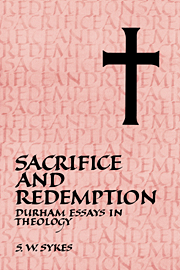Book contents
- Frontmatter
- Contents
- List of contributors
- Prefatory note
- Introduction
- PART I
- 1 Sacrifice and holiness
- 2 Sacrifice and world order: some observations on ben Sira's attitude to the temple service
- 3 Paul's understanding of the death of Jesus as sacrifice
- 4 Hebrews: the final sacrifice
- 5 St Athanasius on Christ's sacrifice
- 6 The doctrine of sacrifice: Augustine and the Latin patristic tradition
- 7 Sacrifice in the early East Syrian eucharistic tradition
- PART II
- PART III
- PART IV
- Index of biblical and ancient references
- Index of persons
3 - Paul's understanding of the death of Jesus as sacrifice
Published online by Cambridge University Press: 10 March 2010
- Frontmatter
- Contents
- List of contributors
- Prefatory note
- Introduction
- PART I
- 1 Sacrifice and holiness
- 2 Sacrifice and world order: some observations on ben Sira's attitude to the temple service
- 3 Paul's understanding of the death of Jesus as sacrifice
- 4 Hebrews: the final sacrifice
- 5 St Athanasius on Christ's sacrifice
- 6 The doctrine of sacrifice: Augustine and the Latin patristic tradition
- 7 Sacrifice in the early East Syrian eucharistic tradition
- PART II
- PART III
- PART IV
- Index of biblical and ancient references
- Index of persons
Summary
The thesis put forward in what follows is that Paul's understanding of Jesus’ life as having representative significance is the key which opens up to us his understanding of the significance of Jesus’ death. Or to put the point in more technical shorthand: Paul's Adam christology is integral to his theology of Jesus’ death as atoning sacrifice. The claim in essence is hardly a new one. It has been familiar in systematic theology in one form or another, as we might say, from Irenaeus (‘theory of recapitulation’ – Kelly 1960,170-4) to Pannenberg (1968, 260-9). But it has been largely ignored or overshadowed in recent decades in New Testament scholarship, with the principal exception of M.D. Hooker (19 71, 1978, 1981), and deserves more attention than it has received. Independently of Hooker I had developed my own version of the thesis (Dunn 1974) and now re-present it in an updated version.
JESUS AS REPRESENTATIVE MAN
The fact that Paul tells us next to nothing about the historical Jesus has always been at the heart of one of the most intractable problems in New Testament theology and Christian origins – the relation between the gospel of Jesus and the theology of Paul. The discontinuity between the two had been stressed by Liberal Protestantism and by the history-of-religions school, particularly W. Heitmiiller (1912) and W. Bousset ([1921] 1970). And although R. Bultmann (1929, [1936] 1960) shared many of their conclusions, he did attempt to demonstrate a significant element of continuity between Jesus and Paul.
- Type
- Chapter
- Information
- Sacrifice and RedemptionDurham Essays in Theology, pp. 35 - 56Publisher: Cambridge University PressPrint publication year: 1991
- 6
- Cited by



